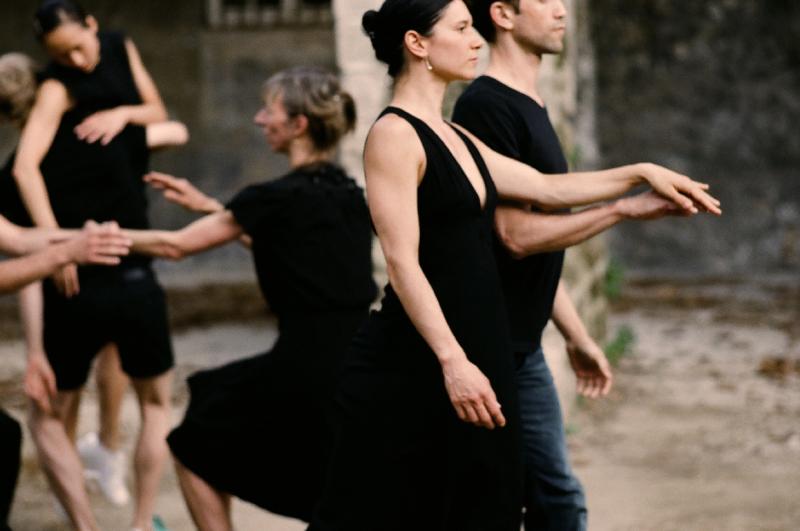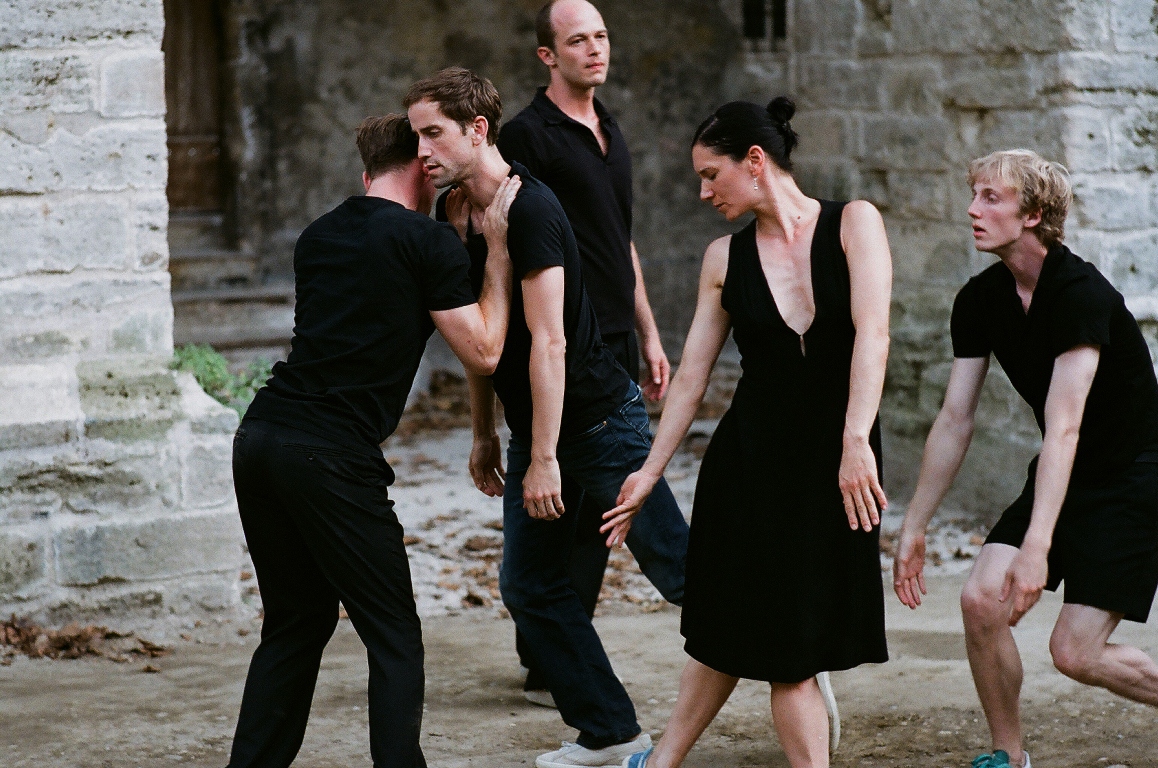Cesena, Anne Teresa De Keersmaeker’s Rosas, Sadler’s Wells | reviews, news & interviews
Cesena, Anne Teresa De Keersmaeker’s Rosas, Sadler’s Wells
Cesena, Anne Teresa De Keersmaeker’s Rosas, Sadler’s Wells
An unmissable world of mystery and ritual from the great choreographer

Well, if De Keersmaeker made us work hard for our enlightenment earlier in the week, we more than get our reward with her triumphant, astonishing Cesena in the second part of her double-programme designed for the Avignon Festival.
Both pieces are built around the form of 14th-century polyphony sung in the south, known today as the ars subtilior, the subtle art. While in En Atendant De Keersmaeker focused on the structure of the music, in Cesena she, together with Björn Schmelzer, founder of graindelavoix, a collective for musicians with an interest in physical theatre, concentrates on its dramatic and emotional effect, creating for us a world of ritual and mystery. The melding of her dancers and his singers is complete – it takes a real effort of will to distinguish one from the other, and one soon realizes there is no point: the 19-strong cast are not singers, not dancers, but performers, unified and impelled by movement and music as one.
We start almost literally in the dark (at Avignon, performed on the city walls, the piece began before dawn). As En Atendant ended with a naked man circling the stage, so Cesena begins with another, bending and shouting into the dark – the dark is the time for nakedness, for baring the selves that in the day we keep covered, whether with clothes or with rationalization. He is soon replaced by the entire cast pacing outwards to us, back to the dark, into the light, back to the dark, over and over, all to the rhythmic beat of what sounds like a chisel on flint.
 The archaic image conjured by the sound is not an accident. It is hard to say quite how De Keersmaeker achieves her sense of the archaic, for there are no theatrical gestures, no mime for “old”. The set, too, is merely the Sadler’s Well’s stage stripped right back to its bare walls, with no wings and no flats, just the nuanced and delicate lighting (courtesy, I assume, of the scenographer, Ann Veronica Janssens), which superficially entirely derives from three fluorescent strips that hang overhead, but magically does so much more.
The archaic image conjured by the sound is not an accident. It is hard to say quite how De Keersmaeker achieves her sense of the archaic, for there are no theatrical gestures, no mime for “old”. The set, too, is merely the Sadler’s Well’s stage stripped right back to its bare walls, with no wings and no flats, just the nuanced and delicate lighting (courtesy, I assume, of the scenographer, Ann Veronica Janssens), which superficially entirely derives from three fluorescent strips that hang overhead, but magically does so much more.
On the floor is a white circle which, it becomes clear as the performers begin to move, brushing and smearing it, is made out of white sand. As they move across it, they leave behind in physical form the shape of their passing, building pictures of a world at once impenetrable to the modern mind, and yet cohesive, if not quite coherent. There is no sense, despite the work's title (Cesena, in today’s Emilia-Romagna, was the site a massacre in 1377, overseen by the man who later became the Avignon antipope Clement VII), that any story is being told, but the emotional resonances, outlined in the music, and in the movement, are never in doubt.
The greatness of De Keersmaeker’s art reveals itself in the simplicity with which she gains her profoundest effects. The company sing a Kyrie, standing on a diagonal across the stage, before moving forward, loomingly, to stare out at us from the front of the stage. Or two women circle the white sand, gently brushing their toes across the surface, turning inwards, half drifting, as though impelled by a sudden thought, rather than De Keersmaeker’s formidable geometrical brain. These are simple things to describe, but they carry incalculable power.
And all the time the music of the ars subtilior winds around our minds, our hearts, to leave an indelible idea of a world that has gone, a sense of intangibility that De Keersmaeker has, none the less, made tangible. By the end we are not so much watching a performance as taking part in a communal event. Unmissable.
- Cesena at Sadler's Wells, tomorrow, 9 November
Buy
Explore topics
Share this article
Add comment
The future of Arts Journalism
You can stop theartsdesk.com closing!
We urgently need financing to survive. Our fundraising drive has thus far raised £49,000 but we need to reach £100,000 or we will be forced to close. Please contribute here: https://gofund.me/c3f6033d
And if you can forward this information to anyone who might assist, we’d be grateful.

Subscribe to theartsdesk.com
Thank you for continuing to read our work on theartsdesk.com. For unlimited access to every article in its entirety, including our archive of more than 15,000 pieces, we're asking for £5 per month or £40 per year. We feel it's a very good deal, and hope you do too.
To take a subscription now simply click here.
And if you're looking for that extra gift for a friend or family member, why not treat them to a theartsdesk.com gift subscription?
more Dance
 'We are bowled over!' Thank you for your messages of love and support
Much-appreciated words of commendation from readers and the cultural community
'We are bowled over!' Thank you for your messages of love and support
Much-appreciated words of commendation from readers and the cultural community
 Peaky Blinders: The Redemption of Thomas Shelby, Rambert, Sadler's Wells review - exciting dancing, if you can see it
Six TV series reduced to 100 minutes' dance time doesn't quite compute
Peaky Blinders: The Redemption of Thomas Shelby, Rambert, Sadler's Wells review - exciting dancing, if you can see it
Six TV series reduced to 100 minutes' dance time doesn't quite compute
 Giselle, National Ballet of Japan review - return of a classic, refreshed and impeccably danced
First visit by Miyako Yoshida's company leaves you wanting more
Giselle, National Ballet of Japan review - return of a classic, refreshed and impeccably danced
First visit by Miyako Yoshida's company leaves you wanting more
 Quadrophenia, Sadler's Wells review - missed opportunity to give new stage life to a Who classic
The brilliant cast need a tighter score and a stronger narrative
Quadrophenia, Sadler's Wells review - missed opportunity to give new stage life to a Who classic
The brilliant cast need a tighter score and a stronger narrative
 The Midnight Bell, Sadler's Wells review - a first reprise for one of Matthew Bourne's most compelling shows to date
The after-hours lives of the sad and lonely are drawn with compassion, originality and skill
The Midnight Bell, Sadler's Wells review - a first reprise for one of Matthew Bourne's most compelling shows to date
The after-hours lives of the sad and lonely are drawn with compassion, originality and skill
 Ballet to Broadway: Wheeldon Works, Royal Ballet review - the impressive range and reach of Christopher Wheeldon's craft
The title says it: as dancemaker, as creative magnet, the man clearly works his socks off
Ballet to Broadway: Wheeldon Works, Royal Ballet review - the impressive range and reach of Christopher Wheeldon's craft
The title says it: as dancemaker, as creative magnet, the man clearly works his socks off
 The Forsythe Programme, English National Ballet review - brains, beauty and bravura
Once again the veteran choreographer and maverick William Forsythe raises ENB's game
The Forsythe Programme, English National Ballet review - brains, beauty and bravura
Once again the veteran choreographer and maverick William Forsythe raises ENB's game
 Sad Book, Hackney Empire review - What we feel, what we show, and the many ways we deal with sadness
A book about navigating grief feeds into unusual and compelling dance theatre
Sad Book, Hackney Empire review - What we feel, what we show, and the many ways we deal with sadness
A book about navigating grief feeds into unusual and compelling dance theatre
 Balanchine: Three Signature Works, Royal Ballet review - exuberant, joyful, exhilarating
A triumphant triple bill
Balanchine: Three Signature Works, Royal Ballet review - exuberant, joyful, exhilarating
A triumphant triple bill
 Romeo and Juliet, Royal Ballet review - Shakespeare without the words, with music to die for
Kenneth MacMillan's first and best-loved masterpiece turns 60
Romeo and Juliet, Royal Ballet review - Shakespeare without the words, with music to die for
Kenneth MacMillan's first and best-loved masterpiece turns 60
 Help to give theartsdesk a future!
Support our GoFundMe appeal
Help to give theartsdesk a future!
Support our GoFundMe appeal

Comments
This was as subtle and